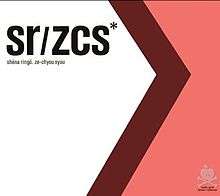Ze-Chyou Syuu
| Ze-Chyou Syuu | ||||
|---|---|---|---|---|
 | ||||
| EP by Ringo Sheena | ||||
| Released | September 13, 2000 | |||
| Recorded |
Shibuya Public Hall (Disc1) NHK Hall (Disc1) Studio Terra (Disc2) Shinjuku Liquidroom (Disc3) | |||
| Genre | J-pop, pop, rock and roll, hard rock, grunge, punk rock, pop rock, jazz, kayōkyoku | |||
| Length |
14:34 (Disc1) 11:25 (Disc2) 08:22 (Disc3) | |||
| Language | Japanese | |||
| Label | Toshiba EMI / Virgin Music | |||
| Producer | Uni Inoue | |||
| Ringo Sheena chronology | ||||
| ||||
Ze-Chyou Syuu (絶頂集 Zetchōshū, "The Acme Collection") is a collection of 3 mini-CDs by Ringo Sheena. It was released on September 13, 2000 by Toshiba EMI / Virgin Music. The RIAJ certified Ze-Chyou Syuu as a gold certified album for 200,000 copies shipped.[1]
Background
After releasing her debut album Muzai Moratorium in February 1999, she toured the album on her six date Senkō Ecstasy tour in April 1999, with her band Gyakutai Glykogen.[2][3] After finishing the tour, Sheena recorded her second album Shōso Strip.[4] After the recording sessions were finished, Sheena embarked on the four date Manabiya Ecstasy tour performed with Tensai Präparat in November, in which Sheena toured university campuses: Tokai University's Shonan Capus in Hiratsuka, Kanagawa, Showa Women's University in Tokyo, Seinan Gakuin University in Fukuoka and Ritsumeikan University in Kyoto.[5]
After the singles "Honnō" (1999), "Gips" (2000) and "Tsumi to Batsu" (2000), Sheena released Shōso Strip on March 31, 2000. It was a great success, being certified for two million copies shipped to stores by the RIAJ.[6] From April to June, Sheena embarked on her 16 date third national tour, Gekokujō Xstasy, starting in Utsunomiya, Tochigi and finishing in Morioka, Iwate.[7] In June and July, Sheena quickly toured again, with a band called Hatsuiku Status.[8] The band performed secret lives and they were not widely publicised.[9]
"So Cold," "Mellow" and "Fukō Jiman" were first performed at November 2, 1999 at Tokai University's Shonan Campus.[10] "Yattsuke Shigoto" and "Gamble" were first performed on April 17, 2000 on the first date of the Gekokujō Xstasy tour.[11] "Onaji Yoru," a song originally appearing on Muzai Moratorium (1999), was first performed on April 1, 1999, on the first date of her Senkō Ecstasy tour in Fukuoka.[2][3] The Hatsuiku Status songs were all brand new, and had not been performed before their June and July 2000 tour.[9]
Concept

The box set was created to look like a medicine case. As the set was composed of 8cm singles, Sheena thought back to the 1980s, the era of 8cm singles and thought of idol Hiroko Mita, who had appeared on many posters for medical products, acting as if her stomach or head hurt. So for the promotional posters, Sheena stood with her head or stomach in pain, with the Ze-Chyou Syuu case advertised on top, as if it were medicine.[12]
The set is composed of three 8cm CDs, each featuring a performance from a different band. Disc 1 features performances by Gyakutai Glykogen from Gekokujō Xstasy. Disc 2 is a collection of studio recordings with Tensai Präparat. Sheena intended for these to be live recordings from their Manabiya Tour, but as the sound quality was not what she wanted, she decided to re-record them. Disc 3 contains three songs from the Hatsuiku Status: Gokiritsu Japon tour.
Two of the songs were given mojibake titles in the Ze-Chyou Syuu booklet: "Onaji Yoru" was written as Jェチ~ッじo?ウ,, and "So Cold" as 喪@CINコ瑠ヲュWァ,.
Promotion
"Yattsuke Shigoto" from given a music video to promote the release. It was shot on the day of the dress rehearsal of the one-night stand live Zazen Ecstasy performed at Kaho Theater of Iizuka-shi, Fukuoka in 2000. All extras playing spectators in the theater were her fans, and they were chosen from her fans who drew a blank in the lottery of the live ticket. The parody of the news report of the various countries in the world at the beginning is used as the introduction part of the music of different arrangement recorded in her third album Kalk Samen Kuri no Hana (2003). In 2006, "Yattsuke Shigoto" was covered by Kera and the Synthesizers on their third album Tonari no Onna.
Track listing
All lyrics written by Ringo Sheena; all music composed by Ringo Sheena unless otherwise noted. All songs arranged and played by each band.
| Disc1: Gyakutai Glycogen | ||
|---|---|---|
| No. | Title | Length |
| 1. | "Yattsuke Shigoto (やっつけ仕事 Rush Job)" | 3:29 |
| 2. | "Gamble (ギャンブル Gamble)" | 5:31 |
| 3. | "Jェチ~ッじo?ウ, Onaji Yoru (同じ夜 Ordinary Night)" | 5:30 |
| Total length: | 14:34 | |
| Disc2: Tensai Praeparat | |||
|---|---|---|---|
| No. | Title | Music | Length |
| 1. | "Mellow (メロウ)" | Makoto Totani and Ringo Sheena[13] | 5:54 |
| 2. | "Fukō Jiman (不幸自慢 Unhappy Pride)[14]" | 2:25 | |
| 3. | "喪@CINコ瑠ヲュWァ, So Cold (喪 興瑠怒(仮))" | 3:05 | |
| Total length: | 11:25 | ||
| Disc3: Hatsuiku Status | |||
|---|---|---|---|
| No. | Title | Music | Length |
| 1. | "Fukurande kichatta (膨らんできちゃった It Expanded)" | 2:06 | |
| 2. | "Hai Hai (はいはい Crawling)" | Ringo Sheena and Hisako Tabuchi | 2:34 |
| 3. | "Kougousei (光合成 Photosynthesis)" | 3:41 | |
| Total length: | 8:22 | ||
Credits and personnel
Disc1: Gyakutai Glycogen (虐待グリコゲン Abuse Glycogen)
- Ringo Sheena - vocals, electric guitar:
- Junji Yayoshi (Sheena’s ex-husband) - electric guitar
- Seiji Kameda - electric bass guitar
- Makoto Minagawa (from Thinners, Sparky) - synthesizer, keyboard instrument
- Masayuki Muraishi - drums
Disc2: Tensai Praeparat (天才プレパラート Genius Praeparat)
- Ringo Sheena - vocals, electric guitar
- Makoto Totani (from Milk Crown, Thinners) - electric guitar
- Eikichi Iwai - electric bass guitar, theremin
- Hisashi Nishikawa (he is Sheena’s friend and an amateur) - Drums
Disc3: Hatsuiku Status (発育ステータス Growth Status)
- Ringo Sheena - vocals, electric bass guitar
- Junko Murata (from Hachioji Gulliver) - electric bass guitar
- Hisako Tabuchi (from Number Girl, toddle, Bloodthirsty Butchers)- electric guitar
- Yasunobu Torii (from Panicsmile, Gaji) - electric bass guitar
- Yuka Yoshimura (of Catsuomaticdeath, Metalchicks, ex-DMBQ, ex-Hydro-Guru, ex-OOIOO, ex-Mensu) - Drums
Notes and references
- ↑ "GOLD ALBUM 他認定作品 2000年9月度" [Gold Albums, and other certified works. September 2000 Edition] (PDF). The Record (Bulletin) (in Japanese). Chūō, Tokyo: Recording Industry Association of Japan. 492: 8. November 10, 2000. Archived from the original (PDF) on January 22, 2014. Retrieved January 22, 2014.
- 1 2 Toshiba EMI (1999). "日程" [Schedule]. Universal. Archived from the original on May 13, 2014. Retrieved May 13, 2014.
- 1 2 Toshiba EMI (1999). "曲目" [Song Order]. Universal. Archived from the original on May 13, 2014. Retrieved May 13, 2014.
- ↑ Ken Tsuda (2000). 「無罪モラトリアム」から「勝訴ストリップ」へ!3月31日待望のセカンドアルバムリリース! [From Muzai Moratorium to Shoso Strip! Her awaited second album released on March 31]. RAT: Shena Ringo News Paper (in Japanese). Universal. Archived from the original on May 4, 2014. Retrieved May 4, 2014.
- ↑ Toshiba EMI (2000). "日程" [Schedule]. Universal. Archived from the original on May 24, 2014. Retrieved May 13, 2014.
- ↑ "GOLD ALBUM 他認定作品 2000年4月度" [Gold Albums, and other certified works. April 2000 Edition] (PDF). The Record (Bulletin) (in Japanese). Chūō, Tokyo: Recording Industry Association of Japan. 487: 8. June 10, 2000. Archived from the original (PDF) on September 22, 2013. Retrieved January 22, 2014.
- ↑ Toshiba EMI (2000). "日程" [Schedule]. Universal. Archived from the original on May 13, 2014. Retrieved May 13, 2014.
- ↑ Toshiba EMI (2000). "日程" [Schedule]. Universal. Archived from the original on May 24, 2014. Retrieved May 24, 2014.
- 1 2 Toshiba EMI (2000). "解説!発育ステータス" [Explanation! Hatsiku Status]. Universal. Archived from the original on May 24, 2014. Retrieved May 24, 2014.
- ↑ Toshiba EMI (1999). "曲目" [Song Order]. Universal. Archived from the original on May 13, 2014. Retrieved May 13, 2014.
- ↑ Toshiba EMI (2000). "曲目" [Song Order]. Universal. Archived from the original on May 13, 2014. Retrieved May 13, 2014.
- ↑ Toshiba EMI (2000). "2000年の真実 『絶頂集』オリコン1位に関して" [The Real Thing (2000) About Ze-Chyou Syuu's Oricon number 1]. Universal. Archived from the original on May 24, 2014. Retrieved May 24, 2014.
- ↑ Ringo Sheena added words to the music which Totani, the guitarist, brought to the band.
- ↑ She replaced "Fuck off G-men" with the Japanese words of the similar sound.